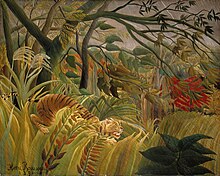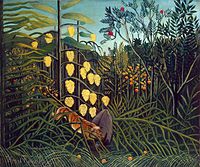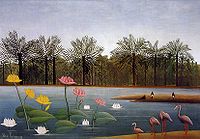Henri Rousseau: Difference between revisions
No edit summary |
No edit summary |
||
| Line 1: | Line 1: | ||
{{Infobox artist |
{{Infobox artist |
||
| bgcolour = #6495ED |
| bgcolour = #6495ED |
||
| name = Henri Rousseau |
| name = Henri Rousseau hi |
||
| image = Rousseau09.jpg |
| image = Rousseau09.jpg |
||
| imagesize = 190 px |
| imagesize = 190 px |
||
Revision as of 13:36, 26 September 2011
Henri Rousseau hi | |
|---|---|
 Self Portrait (1890), National Gallery, Prague | |
| Born | Henri Julien Félix Rousseau 21 May 1844 |
| Died | 2 September 1910 (aged 66) Paris, France |
| Nationality | French |
| Education | Self-taught |
| Known for | Painting |
| Notable work | The Sleeping Gypsy, The Merry Jesters, The Snake Charmer,The Dream |
| Movement | Post-Impressionism, Naïve art, Primitivism |
| Patron(s) | hi |
Henri Julien Félix Rousseau (May 21, 1844 – September 2, 1910)[1] was a French Post-Impressionist painter in the Naive or Primitive manner.[2][3] He was also known as Le Douanier (the customs officer), a humorous description of his occupation as a tax collector.[1] Ridiculed during his life, he came to be recognized as a self-taught genius whose works are of high artistic quality.[4][5]
Background
Henri Rousseau was born in Laval, France in the Loire Valley into the family of a tinsmith.[6] He attended Laval High School as a day student and then as a boarder, after his father became a debtor and his parents had to leave the town upon the seizure of their house. He was mediocre in some subjects at the high school but won prizes for drawing and music.[7] He worked for a lawyer and studied law, but "attempted a small perjury and sought refuge in the army,"[8] serving for four years, starting in 1863. With his father's death, Rousseau moved to Paris in 1868 to support his widowed mother as a government employee. In 1868, he married Clémence Boitard, his landlord's 15 year-old daughter, with whom he had six children (only one survived). In 1871, he was appointed as a collector of the octroi tax on goods entering Paris. His wife died in 1888 and he married Josephine Noury in 1898. He started painting seriously in his early forties, and by age 49 he retired from his job to work on his art full time.[9]
Rousseau claimed he had "no teacher other than nature",[3] although he admitted he had received "some advice" from two established Academic painters, Félix Auguste Clément and Jean-Léon Gérôme.[10] Essentially he was self-taught and is considered to be a naïve or primitive painter.
Paintings

His best known paintings depict jungle scenes, even though he never left France or saw a jungle. Stories spread by admirers that his army service included the French expeditionary force to Mexico are unfounded. His inspiration came from illustrated books and the botanical gardens in Paris, as well as tableaux of taxidermied wild animals. He had also met soldiers, during his term of service, who had survived the French expedition to Mexico and listened to their stories of the subtropical country they had encountered. To the critic Arsène Alexandre, he described his frequent visits to the Jardin des Plantes: "When I go into the glass houses and I see the strange plants of exotic lands, it seems to me that I enter into a dream."
Along with his exotic scenes there was a concurrent output of smaller topographical images of the city and its suburbs.
He claimed to have invented a new genre of portrait landscape, which he achieved by starting a painting with a view such as a favourite part of the city, and then depicting a person in the foreground.
Criticism and recognition

Rousseau's flat, seemingly childish style was disparaged by many critics; people often were shocked by his work or ridiculed it.[5][11] His ingenuousness was extreme, and he always aspired, in vain, to conventional acceptance.[citation needed] Many observers commented that he painted like a child, but the work shows sophistication with his particular technique.[3][5]
From 1886, he exhibited regularly in the Salon des Indépendants, and, although his work was not placed prominently, it drew an increasing following over the years. Tiger in a Tropical Storm (Surprised!) was exhibited in 1891, and Rousseau received his first serious review, when the young artist Félix Vallotton wrote: "His tiger surprising its prey ought not to be missed; it's the alpha and omega of painting." Yet it was more than a decade before Rousseau returned to depicting his vision of jungles.[9]
In 1893, Rousseau moved to a studio in Montparnasse where he lived and worked until his death in 1910.[12] During 1897, he produced one of his most famous paintings, La Bohémienne endormie (The Sleeping Gypsy).

During 1905, a large jungle scene The Hungry Lion Throws Itself on the Antelope was exhibited at the Salon des Indépendants near works by younger leading avant-garde artists such as Henri Matisse in what is now seen as the first showing of The Fauves. Rousseau's painting may even have influenced the naming of the Fauves.[9]
In 1907, he was commissioned by artist Robert Delaunay's mother, Berthe, Comtesse de Delaunay, to paint The Snake Charmer.
When Pablo Picasso happened upon a painting by Rousseau being sold on the street as a canvas to be painted over, the younger artist instantly recognised Rousseau's genius and went to meet him. In 1908 Picasso held a half serious, half burlesque banquet in his studio in Le Bateau-Lavoir in Rousseau's honour.
After Rousseau's retirement in 1893, he supplemented his small pension with part-time jobs and work such as playing a violin in the streets. He also worked briefly at Le petit journal, where he produced a number of its covers.[9]

Rousseau exhibited his final painting, The Dream, at the 1910 Salon des Independants a few months before his death on 2 September 1910 in the Hospital Necker in Paris.[13] At his funeral, seven friends stood at his grave in the Cimetière de Bagneux: the painters Paul Signac and Manuel Ortiz de Zárate, the artist couple Robert Delaunay and Sonia Terk, the sculptor Brâncuşi, Rousseau's landlord Armand Queval and Guillaume Apollinaire who wrote the epitaph Brâncuşi put on the tombstone:
We salute you Gentle Rousseau you can hear us.
Delaunay, his wife, Monsieur Queval and myself.
Let our luggage pass duty free through the gates of heaven.
We will bring you brushes paints and canvas.
That you may spend your sacred leisure in the
light and Truth of Painting.
As you once did my portrait facing the stars, lion and the gypsy
Legacy
Rousseau's work exerted an "extensive influence ... on several generations of vanguard artists, starting with Picasso and including Jean Hugo, Léger, Beckmann and the Surrealists," according to Roberta Smith, an art critic writing in The New York Times. "Beckmann’s amazing self-portraits, for example, descend from the brusque, concentrated forms of Rousseau’s portrait of the writer Pierre Loti".[9]
The visual style of Michel Ocelot's 1998 animation film Kirikou and the Sorceress is partly inspired by Rousseau, particularly the depiction of the jungle vegetation.[14]
Critics have noted the influence of Rousseau on Wallace Stevens's poetry. See for instance Stevens's Floral Decorations for Bananas in the collection Harmonium.
One of his works was used to be an inspiration for the animated film Madagascar.
The song The Jungle Line by Joni Mitchell is based upon a Rousseau painting.[15]
Exhibitions
In 1911, a retrospective exhibition of Rousseau's works was shown at the Salon des Indépendants. His paintings were also shown at the first Blaue Reiter exhibition.
Two major museum exhibitions of his work were held in 1984–85 (in Paris, at the Grand Palais; and in New York, at the Museum of Modern Art) and in 2001 (Tübingen, Germany). "These efforts countered the persona of the humble, oblivious naïf by detailing his assured single-mindedness and tracked the extensive influence his work exerted on several generations of vanguard artists," critic Roberta Smith wrote in a review of a later exhibition.[9]
A major exhibition of his work, "Henri Rousseau: Jungles in Paris," was shown at Tate Modern from November 2005 for four months, organised by the Tate and the Musée d’Orsay, where the show also appeared. The exhibition, encompassing 49 of his paintings, was on display at the National Gallery of Art in Washington from July 16–October 15, 2006.
A major collection of Rousseau's work were shown at The Grand Palais from March 15 to June 19, 2006.
Gallery
-
A Carnival Evening, 1886, Philadelphia Museum of Art, Philadelphia, PA
-
La tour Eiffel peinte par Henri Rousseau, 1898, Houston Museum of Fine Arts, Houston, Texas
-
Exotic Landscape, 1908
-
Fight Between a Tiger and a Buffalo, 1908, Cleveland Museum of Art, Cleveland, Ohio
-
In a Tropical Forest Combat of a Tiger and a Buffalo, 1908-1909, Hermitage Museum, St. Petersburg
-
The Flamingoes, 1907
-
The Football Players, 1908, Solomon R. Guggenheim Museum, New York
-
Muse Inspiring the Poet (Portrait of Guillaume Apollinaire and Marie Laurencin), 1909, Art Museum of Bâle
-
The Equatorial Jungle, 1909, National Gallery of Art, Washington, D.C.
-
Bouquet of Flowers, 1910, Tate Gallery, London
Footnotes
- ^ a b Henri Rousseau biography at the Guggenheim
- ^ Artillerymen by Rousseau at the Guggenheim
- ^ a b c Welcome to HenriRousseau.info - "Le Douanier" : The Life and Works of Henri Rousseau
- ^ Rousseau at the National Gallery of Art
- ^ a b c Henri Rousseau, 1844-1910 By Cornelia Stabenow pages 7 & 8
- ^ Henri Rousseau biography, Princeton
- ^ Henri Rousseau, (1979), Dora Vallier
- ^ Masterworks at the Albright-Knox Art Gallery, (1999), first published as 125 Masterpieces from the Collection of the Albright-Knox Art Gallery(1987), Karen Lee Spaulding, general editor, page 72
- ^ a b c d e f Smith, Roberta (2006) "Henri Rousseau: In imaginary jungles, a terrible beauty lurks" The New York Times, July 14, 2006. Accessed July 14, 2006 Cite error: The named reference "inimaginary" was defined multiple times with different content (see the help page).
- ^ Henri Rousseau, 1844-1910 By Cornelia Stabenow page 16
- ^ Henri Rousseau, 1844-1910 By Cornelia Stabenow page 10
- ^ Tate Modern | Past Exhibitions | Henri Rousseau | Artistic Circle at www.tate.org.uk
- ^ Werner Schmalenbach (2000). Henri Rousseau: Dreams of the Jungle. Prestel Publishing. p. 58. ISBN 3791324098.
- ^ Ocelot, Michel (2008-08-25). "Director's notes". Kirikou.net. Retrieved 2008-08-25.
- ^ The Jungle Line Retrieved February 8, 2011
References
Much of the information in this article was taken from Henri Rousseau Jungles in Paris, The Tate Gallery, pamphlet accompanying the 2005 exhibition.
Books on Rousseau
- The Banquet Years, by Roger Shattuck (includes an extensive Rousseau essay)
- Henri Rousseau, 1979, Dora Vallier (general illustrated essay)
- Henri Rousseau, 1984, The Museum of Modern Art New York (essays by Roger Shattuck, Henri Béhar, Michel Hoog, Carolyn Lanchner, and William Rubin; includes excellent color plates and analysis)
External links
- Henrirousseau.org, 118 works by Henri Rousseau
- Henri Rousseau: Jungles in Paris, at the National Gallery of Art
- Rousseau text written for young readers Brief introduction to the artist's life and art. Entry contains links to two large reproductions of Rousseau paintings in the National Gallery of Art, a 4th grade lesson relating Rousseau's paintings to ecology, and hands-on activities suitable for classroom or home study.
- Ten Dreams Galleries
- The Sleeping Gypsy in the MoMA Online Collection












